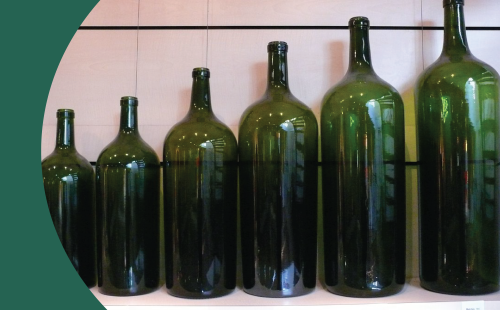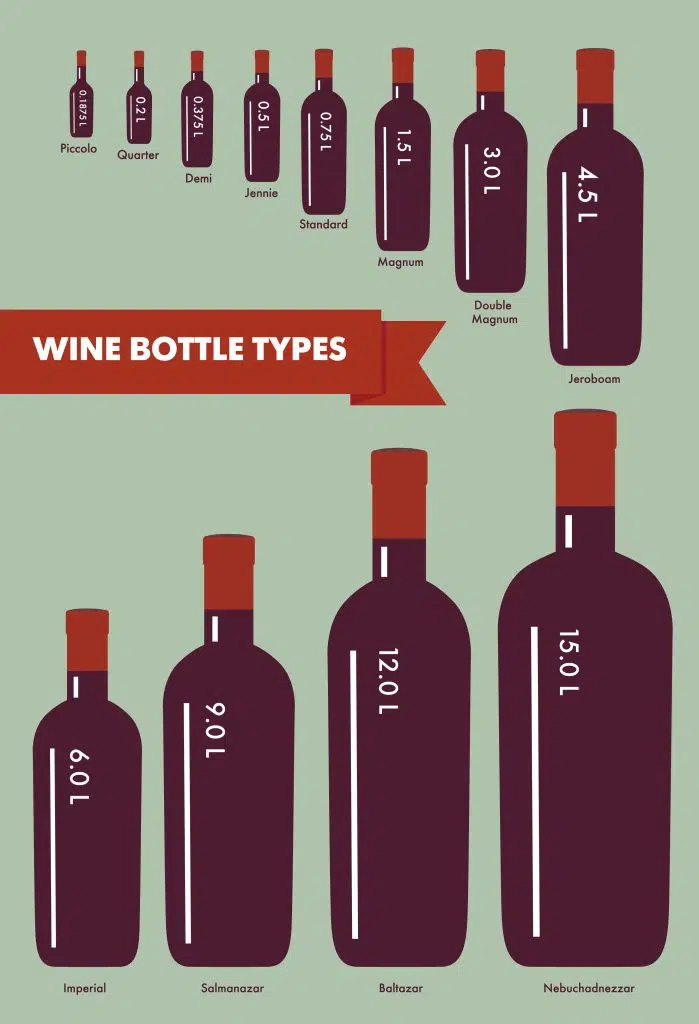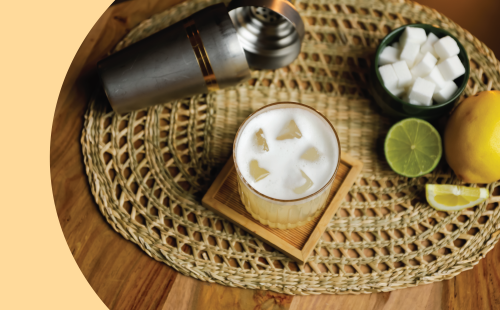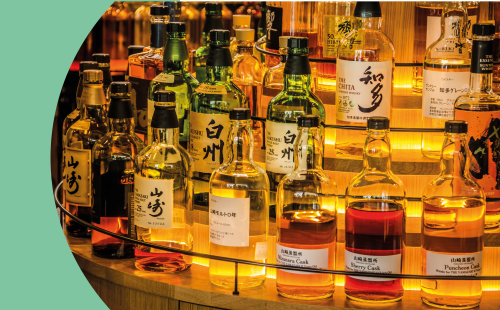You’ve probably reached for a bottle of wine at your favorite store and noticed that they don’t all look the same. Some are small and cute—perfect for a single glass—while others look like they belong in a wine cellar at a royal banquet.
Why should we care? Well, the dimension of a wine bottle can change everything from how long the wine will last, how well it ages, and even how it tastes when you uncork it.
This is a detailed chart of wine bottle sizes this article will cover, including their names, volume in liters (L), ounces (oz), and height in inches:
| Wine Bottle Name | Liters (L) | Ounces (oz) | Height (inch) | Height (cm) |
| Piccolo (Split) | 0.1875 | 6.34 | 7.5 | 19.0 |
| Demi (Half) | 0.375 | 12.68 | 9.5 | 24.1 |
| Standard | 0.75 | 25.36 | 12.0 | 30.5 |
| Magnum | 1.5 | 50.72 | 13.5 | 34.3 |
| Jeroboam | 3.0 | 101.44 | 18.0 | 45.7 |
| Rehoboam | 4.5 | 152.16 | 22.0 | 55.9 |
| Methuselah | 6.0 | 202.88 | 22.0 | 55.9 |
| Salmanazar | 9.0 | 304.32 | 25.0 | 63.5 |
| Balthazar | 12.0 | 405.76 | 26.0 | 66.1 |
| Nebuchadnezzar | 15.0 | 507.2 | 30.0 | 76.2 |
| Melchior | 18.0 | 608.64 | 34.0 | 86.4 |
| Solomon | 20.0 | 676.28 | 35.0 | 88.9 |
| Primat | 27.0 | 913.92 | 40.0 | 101.6 |
| Melchizedek | 30.0 | 1014.4 | 42.0 | 106.7 |
Standard Wine Bottle Size: The 750 ml Bottle
Let’s kick things off with the size we’re all most familiar with—the 750 ml bottle. The industry standard, this bottle is what you’ll find on most store shelves. But did you know that the reason behind its exact size has some fascinating theories?
One theory suggests that it was based on the lung capacity of glassblowers back in the day. In those times, glassblowers could only blow so much glass in one go, and 750 ml was what most could manage consistently. Another reason might be more practical: 750 ml bottles fit perfectly into wooden crates for transport in quantities of 12, which equals 9 liters—an ideal size for distribution.
For us, the 750 ml bottle is the go-to. Whether we share a bottle over dinner or store it for a special occasion, this size just works. But the world of wine bottle sizes doesn’t stop here. Let’s explore the other, lesser-known sizes.
Small Wine Bottles – When Less is More
Sometimes, you don’t want an entire 750 ml bottle. Maybe you’re just tasting a wine, or perhaps you’re having a solo night in (we’ve all been there!). That’s where small bottles come in handy. These sizes pack just enough wine without overwhelming you, and they’re perfect for personal indulgence or smaller gatherings.
Piccolo or Split (187.5 ml)
The Piccolo, also called a Split, holds just enough for one glass of wine. It’s most commonly seen with Champagne, making it the perfect size for single servings of bubbly. If you’re not ready to commit to a full bottle, this is the size for us. It’s also a fun choice for gifts or picnics.
Demi or Half Bottle (375 ml)
Next up is the Demi, or half-bottle, which holds exactly half the amount of a standard bottle. This size is ideal for intimate dinners where two people want just a few glasses, or for testing out a new wine without committing to a full 750 ml. Plus, half bottles age slightly quicker due to the higher oxygen-to-wine ratio. If you’re impatient like us, a half bottle of a well-aged wine can be a smart move.
Large Wine Bottles – When More is Better
For those of us who love to entertain or want to age wine like a pro, large-format bottles are where it’s at. Not only do they make an impression, but they also offer some practical benefits when it comes to aging wine. Larger bottles allow wine to age over longer periods of time, resisting temperature changes more easily, allowing wines to develop more complex flavors over time.
Magnum (1.5 L)
If you’ve ever been to a wedding or a big celebration, you’ve probably seen a Magnum. It’s double the size of a standard bottle and is perfect for those of us who want to make a statement. Magnums are also favored for aging red wines because the larger volume allows the wine to age more slowly and gracefully. Next time you’re hosting, grab a magnum—you’ll look like a pro!
Jeroboam (3 L)
A Jeroboam holds the equivalent of four standard bottles of wine. It’s named after the biblical King Jeroboam, because, let’s face it, anything this grand needs a legendary name. Jeroboams are often used for Champagne or Bordeaux wines, and they’re a sight to behold when brought to the table.
Rehoboam (4.5 L)
We’re getting into serious territory now. The Rehoboam, named after another biblical king, holds six bottles worth of wine. Typically, you’ll find this size in the Champagne world. If you’re looking to impress, a Rehoboam is the way to go. Just make sure you have enough friends over to help you drink it!
Methuselah (6 L)
Methuselah was known for his long life, and wines in Methuselah bottles are known for their long aging potential. Holding eight bottles of wine, these are usually used for red wines that need time to evolve. Trust us, if you ever manage to get your hands on one of these, hold onto it for a special occasion.
Salmanazar (9 L)
Nine liters of wine—imagine pouring from this! A Salmanazar is perfect for large events, and while it’s rare to see them, they’re unforgettable. If you’re a collector, a Salmanazar of vintage Champagne is a jewel in the cellar.
Balthazar (12 L)
At this point, we’re talking about bottles that hold a full case of wine. Balthazar bottles are often reserved for once-in-a-lifetime moments like weddings, galas, or, you know, the times we just feel extra fancy.
Nebuchadnezzar (15 L)
Nebuchadnezzar was a king of Babylon, so it’s fitting that this bottle holds a king-sized 15 liters of wine. That’s the equivalent of 20 standard bottles. If you’ve got one of these in your cellar, you’re either hosting the party of the century or are a very serious wine enthusiast.
Extreme and Rare Wine Bottle Sizes
If you think Nebuchadnezzar is as big as it gets, think again. The wine world has pushed the limits with even larger bottles that are rarely seen outside of auctions or special events.
Melchior (18 L)
Named after one of the Three Wise Men, this 18-liter bottle is primarily used for Bordeaux and is a rare find even among collectors. It’s the kind of bottle you’ll see at high-end wine auctions, often fetching a premium price.
Solomon (20 L)
A massive bottle, the Solomon holds 20 liters of wine and is typically only produced in very limited quantities by prestigious wineries. Imagine serving a wine from this at your next dinner party!
Primat (27 L)
This beast of a bottle holds the equivalent of 36 standard bottles. Produced in extremely limited quantities, it’s mostly reserved for grand events or for the super-elite wine collectors.
Melchizedek (30 L)
The rarest and largest of them all, the Melchizedek holds a staggering 40 bottles of wine. It’s named after a priest-king from the Bible, which is fitting for a bottle that carries such prestige. If you ever encounter one of these, you’re witnessing a true masterpiece in the world of wine.
Bottle Shapes and Sizes by Wine Type
Wine bottle shapes don’t just serve as a visual cue; they carry deep significance tied to the region, the type of wine, and even tradition.
Bordeaux Bottles
The Bordeaux bottle is probably one of the most recognizable out there, with its straight sides and pronounced shoulders. The design is practical as much as it is stylish. The high shoulders help trap sediment, which can accumulate in red wines that age for a long time—like those robust Cabernets and Merlots that the Bordeaux region is famous for. So, when you’re pouring from a Bordeaux bottle, especially an older vintage, you can decant it carefully and avoid getting that gritty sediment in your glass. It’s a shape that’s designed for both function and elegance.

Burgundy Bottles
Now, Burgundy bottles are where we start to see a softer, rounder form. These bottles have sloping shoulders and a wider base, which gives them a unique profile. Traditionally, this shape was used for wines like Pinot Noir and Chardonnay. The reason for this design is more historical than functional—Burgundy winemakers chose this shape centuries ago, and it’s become a signature of the region ever since. When you see that gentle slope, you know you’re in for something elegant and refined. The wide base also makes it easy to store, but it takes up more room in wine racks.

Champagne Bottles
Ah, Champagne bottles—thick, sturdy, and built to handle the pressure. Literally! Sparkling wines, especially those made in the traditional Champagne method, are under immense pressure due to the carbon dioxide trapped inside. Champagne bottles are thicker and have a deep punt (the dent at the bottom), which helps distribute pressure. The bottle’s heavier glass prevents any explosive incidents, and the punt allows easier handling when pouring. It’s a bottle that’s all about functionality, with a touch of class.

Why Do Wine Bottle Sizes Matter?
We’ve talked about bottle shapes, but why does the size of the bottle matter so much? It’s not just about how much wine is in there. Bottle size has a direct effect on how wine ages, how it’s presented, and even how it tastes.
Effect on Aging
The size of the bottle plays a huge role in how wine ages. Larger bottles like magnums (1.5 L) and beyond are not just for show—they actually preserve wine better over time. Why? It’s all about the ratio of oxygen to wine. In larger bottles, there’s relatively less oxygen interacting with the wine and less impact of thermal variations, which means the aging process is slower and more graceful. Wines stored in large bottles tend to develop deeper, more complex flavors over the years. On the flip side, smaller bottles like half-bottles (375 ml) age faster because there’s more oxygen exposure per milliliter of wine. So, if you’re looking to store a wine for a long time, bigger is definitely better.
Cost Efficiency and Presentation
Larger bottles not only look impressive on the table, but they can also offer better value for money. Buying a magnum or even a Jeroboam (3 L) can be more cost-effective than purchasing multiple smaller bottles, especially if you’re buying wine for a big event. Plus, pouring from a magnum or larger bottle makes for a memorable experience. There’s something special about serving wine from a grand bottle—it immediately elevates the occasion. And let’s be real: it just looks cool.
Impact on Wine Flavor and Preservation
The size of a bottle also affects the taste of the wine. As we mentioned, larger bottles preserve wine better over time because they minimize oxygen exposure, which means the wine ages slower and keeps its flavor profile intact. Smaller bottles, on the other hand, are more susceptible to changes in temperature and oxygen levels, which can alter the taste of the wine more quickly. So, when you want to savor a wine over the years, opt for a larger bottle—it’s worth the wait.
Fun Facts and Trivia About Wine Bottles
Wine bottle sizes come with a history that’s as rich as the wine itself. Let’s sprinkle in some fun facts and trivia:
- Biblical Names for Giant Bottles: Ever wondered why large bottles are named after biblical kings? Names like Jeroboam, Methuselah, and Nebuchadnezzar all have roots in the Bible. These names were chosen for their grandeur, which is fitting since these bottles are often reserved for the finest wines or the most significant celebrations.
- The Most Expensive Wine Bottle: The title of the most expensive bottle of wine sold goes to a 1947 Cheval Blanc, which fetched an eye-watering $304,375 at auction. And what bottle size was it? A magnum, of course!
- Record-Setting Bottle Sizes: The largest wine bottle ever made was a massive 4.17 meters tall that could hold 3.094 liters of wine! It was created in Lebanon and holds the record for the world’s biggest bottle.






